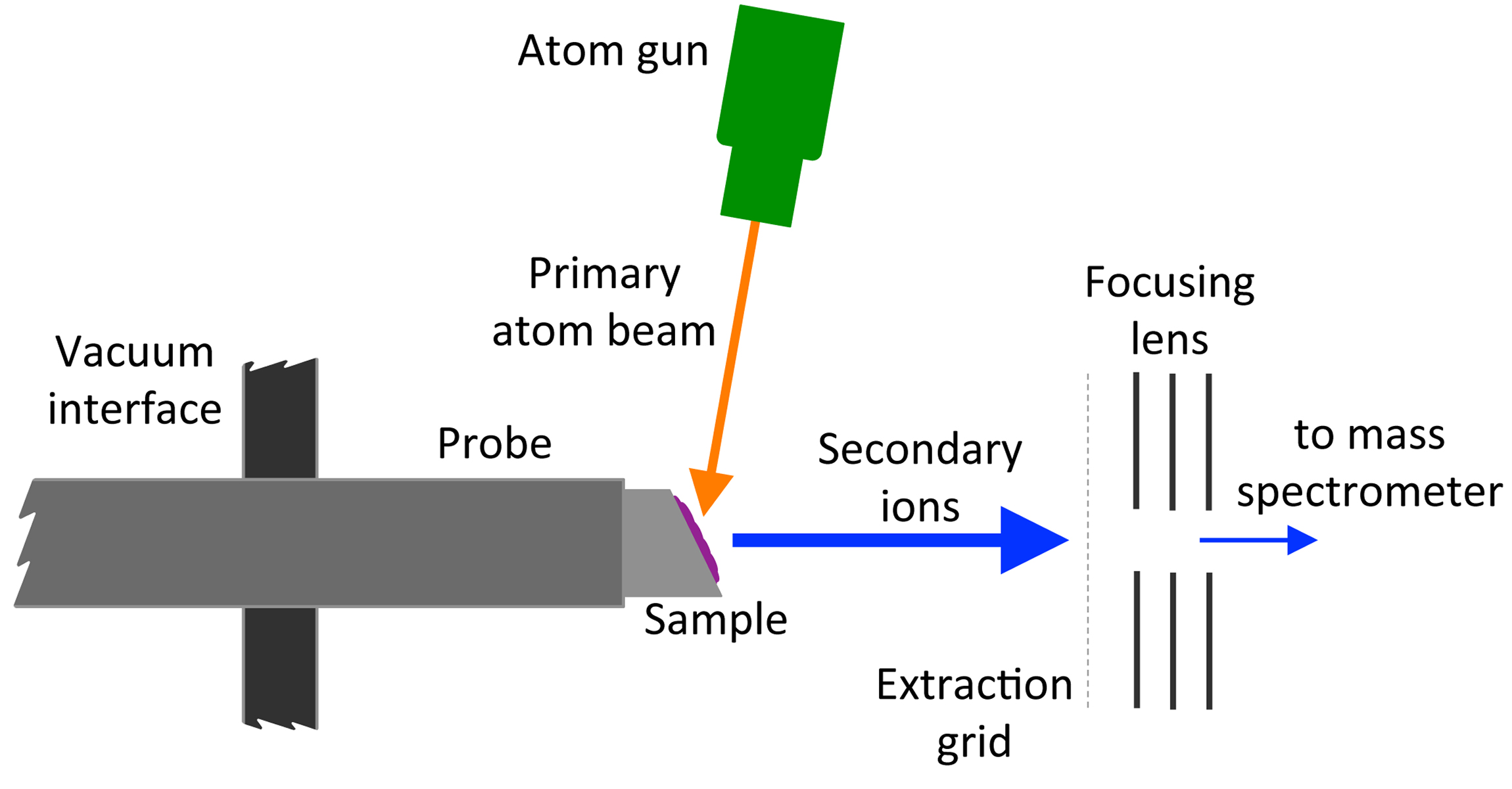Fast atom bombardment ionization: Difference between revisions
No edit summary |
No edit summary |
||
| (7 intermediate revisions by 2 users not shown) | |||
| Line 1: | Line 1: | ||
{{ | {{Final | ||
|acronym=([[FAB]]) | |||
|def=[[Ion]]ization of molecules initiated by a beam of neutral atoms with translational energies in the keV range. Labile molecules susceptible to dissociation are dissolved in an involatile liquid matrix that absorbs the energy of the bombarding atoms to form a selvedge region above the liquid surface in which ionization of the molecules occurs. | |||
:''Note'': Positive ions (e.g., [[protonated molecule|protonated]] or [[cationized molecule]]s) or negative ions (e.g., [[deprotonated molecule]]s) are formed depending on the polarity of ionization. | |||
|rel=[[liquid secondary ionization]] | |||
|ref={{obgb}} | |||
with additional information from H. R. Morris, M. Panico, M. Barber, R. S. Bordoli, R. D. Sedgwick, A. N. Tyler. Biochem. Biophys. Res. Comm. 101, 623 (1981). (http://dx.doi.org/10.1016/0006-291X(81)91304-8 ) | |||
{{psims|1000074}} | |||
}} | }} | ||
<!-- Orange Book --> | |||
{{ | {{orange| | ||
This term refers to the ionization of any species by causing interaction of the sample (which may be dissolved in a solvent matrix) and a beam of neutral atoms having a high translational energy. (See also [[Secondary Ionization]]). | This term refers to the ionization of any species by causing interaction of the sample (which may be dissolved in a solvent matrix) and a beam of neutral atoms having a high translational energy. (See also [[Secondary Ionization]]). | ||
}} | }} | ||
<!-- Gold Book --> | |||
{{gold| | {{gold| | ||
'''fast-atom bombardment (FAB) mass spectroscopy''' | '''fast-atom bombardment (FAB) mass spectroscopy''' | ||
| Line 20: | Line 30: | ||
}} | }} | ||
== | ==Gallery== | ||
{{Gallery | |||
|file=File:Fast atom bombardment diagram.png|caption=Diagram showing the process of fast atom bombardment ionization of a solid sample dissolved in a matrix.}} | |||
{{gallery|file=File:FAB Schematic.jpg|caption=Schematic of the mass spectrometry ionization method fast atom bombardment (FAB) also known as [[liquid secondary ionization mass spectrometry]] ([[LSIMS]]).}} | |||
[[Category:Ionization]] | [[Category:Ionization]] | ||
Latest revision as of 15:30, 4 July 2025
| IUPAC RECOMMENDATIONS 2013 |
| Fast atom bombardment ionization (FAB) |
|---|
Ionization of molecules initiated by a beam of neutral atoms with translational energies in the keV range. Labile molecules susceptible to dissociation are dissolved in an involatile liquid matrix that absorbs the energy of the bombarding atoms to form a selvedge region above the liquid surface in which ionization of the molecules occurs.
|
| Related Term(s): liquid secondary ionization |
| Reference(s):
IUPAC. Analytical Division. Compendium of Analytical Nomenclature (the Orange Book). Definitive Rules, 1979. Compiled by J. Inczdy, T. Lengyel, A. M. Ure. Blackwell Scientific Publications, Oxford (1997). On-line corrected version: http://www.iupac.org /publications/analytical compendium (2000). IUPAC. Compendium of Chemical Terminology, 2nd ed. (the Gold Book). Compiled by A. D. McNaught and A.Wilkinson. Blackwell Scientific Publications, Oxford (1997). XML on-line corrected version: http://goldbook.iupac.org (2006-) created by M. Nic, J. Jirat, B. Kosata; updates compiled by A. Jenkins. with additional information from H. R. Morris, M. Panico, M. Barber, R. S. Bordoli, R. D. Sedgwick, A. N. Tyler. Biochem. Biophys. Res. Comm. 101, 623 (1981). (http://dx.doi.org/10.1016/0006-291X(81)91304-8 )
|
| From Definitions of Terms Relating to Mass Spectrometry (IUPAC Recommendations 2013); DOI: 10.1351/PAC-REC-06-04-06 © IUPAC 2013. |
Orange Book
| ORANGE BOOK DEFINITION
IUPAC. Analytical Division. Compendium of Analytical Nomenclature (the Orange Book). Definitive Rules, 1979 (see also Orange Book 2023) |
| Fast atom bombardment ionization |
|---|
|
This term refers to the ionization of any species by causing interaction of the sample (which may be dissolved in a solvent matrix) and a beam of neutral atoms having a high translational energy. (See also Secondary Ionization). |
| IUPAC 1997 Orange Book Chapter 12 |
| Index of Orange Book Terms |
Gold Book
| GOLD BOOK DEFINITION
IUPAC. Compendium of Chemical Terminology, 2nd ed. (the Gold Book). Compiled by A. D. McNaught and A.Wilkinson. Blackwell Scientific Publications, Oxford (1997). |
| Fast atom bombardment ionization |
|---|
|
fast-atom bombardment (FAB) mass spectroscopy http://goldbook.iupac.org/F02328.html A method in which ions are produced in a mass spectrometer from non-volatile or thermally fragile organic molecules by bombarding the compound in the condensed phase with energy-rich neutral particles. Source: PAC, 1994, 66, 1077 (Glossary of terms used in physical organic chemistry (IUPAC Recommendations 1994)) on page 1115 |
| IUPAC Gold Book |
| Index of Gold Book Terms |
Gallery


